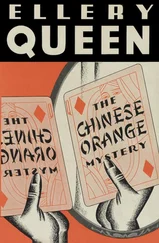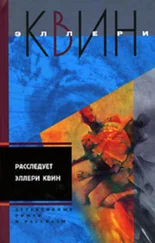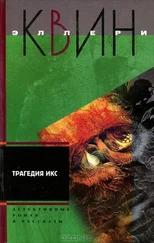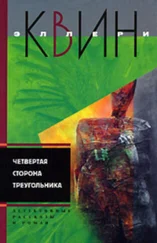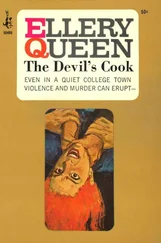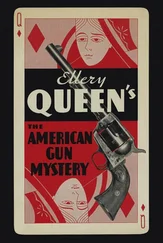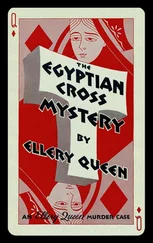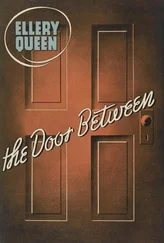Эллери Куин - The Madman Theory
Здесь есть возможность читать онлайн «Эллери Куин - The Madman Theory» весь текст электронной книги совершенно бесплатно (целиком полную версию без сокращений). В некоторых случаях можно слушать аудио, скачать через торрент в формате fb2 и присутствует краткое содержание. Город: New York, Год выпуска: 1966, Издательство: Pocket Books, Жанр: Криминальный детектив, на английском языке. Описание произведения, (предисловие) а так же отзывы посетителей доступны на портале библиотеки ЛибКат.
- Название:The Madman Theory
- Автор:
- Издательство:Pocket Books
- Жанр:
- Год:1966
- Город:New York
- ISBN:нет данных
- Рейтинг книги:5 / 5. Голосов: 1
-
Избранное:Добавить в избранное
- Отзывы:
-
Ваша оценка:
- 100
- 1
- 2
- 3
- 4
- 5
The Madman Theory: краткое содержание, описание и аннотация
Предлагаем к чтению аннотацию, описание, краткое содержание или предисловие (зависит от того, что написал сам автор книги «The Madman Theory»). Если вы не нашли необходимую информацию о книге — напишите в комментариях, мы постараемся отыскать её.
But Inspector Omar Collins, lean, gloomy-eyed, black-haired, was a painstaking man.
The more he pursued it, the less he believed in The Madman Theory.
The Madman Theory — читать онлайн бесплатно полную книгу (весь текст) целиком
Ниже представлен текст книги, разбитый по страницам. Система сохранения места последней прочитанной страницы, позволяет с удобством читать онлайн бесплатно книгу «The Madman Theory», без необходимости каждый раз заново искать на чём Вы остановились. Поставьте закладку, и сможете в любой момент перейти на страницу, на которой закончили чтение.
Интервал:
Закладка:
Once again he studied the semicircle of faces. Earl Junior sat there smirking. Buck James, close by Jean Genneman, stared back with something like defiance while Jean herself frowned down at her hands. Myron Retwig, in a big overstuffed chair, gazed ruminatively at the ceiling. Red Kershaw looked worried; Bob Vega, wearing a gray silk Italian suit, sat tilting his head this way and that. Opal Genneman’s face was expressionless — it was impossible even to guess at her thoughts.
“All of us want to see these murders cleared up, and it might be just some trifle that would turn the trick. For instance, there’s a mysterious white Ford Galaxie hardtop, license LKK-3220, in the picture. Does anyone have knowledge regarding this car?”
Myron Retwig spoke in a voice merely curious. “How does the car enter the case?”
Collins chose his words carefully. There was an extremely fine distinction between saying too little and too much. “I’ll have to go into some background to answer. The police naturally are forced to work methodically. We have to comb the ground for every bit of information. We’re pluggers. Sooner or later we consider every possible angle to a case — maybe a few impossible ones.
“You people have noticed that, when you enter the park, you receive a receipt for your fee on which is noted your license number. We made a list of such numbers and checked every car which entered the park during the week previous to the murder. One of these cars was registered to a Nathan Wingate of Redondo Beach, who denied ever setting foot in the park. Another was registered to Steve Ricks of Fresno. Steve Ricks was killed on the night of Tuesday, June 16, and his body flung into a boxcar. We identified him without too much trouble; we have a few tricks of the trade we don’t talk about too much. Right, Captain?”
“Right,” said Bigelow.
“Naturally we investigated Steve Ricks to a fare-thee-well. We know more about Ricks than his own mother. We found that on Friday, June 12, he drove a white Ford, license LKK-3220. Evidently this particular car is involved in the murder, which is why I asked my question. Is that clear, Mr. Retwig?”
“Quite clear, thank you.”
“We traced Ricks to San Jose and certain of his hangouts, notably a place called Smoky Joe’s Down Home Cabaret, on Latham Avenue. Some of you people may know it. At Smoky Joe’s, Ricks met Mr. Kershaw here, through one of Mr. Kershaw’s ex-wives. Now the story becomes blurred. Apparently Ricks was hired for two hundred dollars — a hundred down, a hundred later — to help play a trick on someone in the camping party. So much Steve confided to a friend. Unfortunately, he did not name the person who hired him to play the trick. In any event we can definitely rule out Ricks as the murderer of Mr. Genneman — even though Ricks was the man who came behind you gentlemen on the trail. This is absolutely definite; we have ironclad proof of it.
“So this is about where we stand. Someone — either Steve Ricks or the murderer — drove a rented white Ford with faked plates up into General Grant Park on Wednesday, June 10. I personally feel that it was the murderer. Since he described Persimmon Lake to Ricks, we know that he was familiar with the country, at least as far as Lomax Falls. Why he should have made a previous trip up the trail is a puzzle: perhaps to scout out a good place for an ambush.
“I’m likewise perplexed by the ease with which he made his escape. I’ve got a notion he slid down the mountainside, gun and all. The next few days I’m tied up in court on another case, but early next week I hope to make a careful inspection of the whole area, including the valley below. Maybe I’ll find some traces... Well, we’ll see what we see.”
Collins again paused for breath. Was he laying it on too thick? He went on, to avoid placing undue emphasis on the shotgun. “As to motive, we’re in the dark. We simply don’t know who had it in for Mr. Genneman, or why. As of now we seem to have come to a dead end. Unless we can find some evidence at the scene of the crime we may have to go back to the theory of a maniac — and nobody wants that, especially the rangers. Well, that’s my report. If any of you have any ideas, I’d be happy to hear them.”
Earl Junior formed a short word with his mouth, which Collins chose to ignore. “Anybody have any questions?”
No one had any questions.
“In that case,” said Collins, “the party’s over. In a week or two I hope to have more news for you. Good night.”
Collins and Bigelow went out to their car and started back to Fresno. “Well?” asked Collins. “What do you think? Did I lay it on too thick?”
“I wouldn’t say so. If you’d been any less explicit, the message might not have come through.”
“That was my feeling. Well, we’ll see.”
At two o’clock the following afternoon, Collins answered his telephone to hear the even voice of Lieutenant Loveridge. “We’ve got action up here. Just about what you predicted.”
Collins drew a deep breath. “I was afraid I’d muffed it. What’s going on?”
“Subject is proceeding east, driving a black Corvair rented from Hertz. License BR9-019.”
“Got it. Keep well back. Better lose contact than get the suspect wise.”
“We’re using three unmarked cars,” said Loveridge. “Traffic’s heavy; there won’t be any foul-up. They’ll keep in touch by radio, and I’ll keep your office posted.”
Collins notified Bigelow, then telephoned Park Superintendent Phelps. “Inspector Omar Collins here, Superintendent. We’ve got action. I’m on my way to the airport. I’ll meet you at Cedar Grove as arranged.”
“Very well, Inspector. Glad to hear the news.”
Collins went into Bigelow’s office. “I’m on my way.”
“Have a joy ride. I’ll take care of this end.”
Half an hour later Collins and Sergeants Easley and Kerner arrived at the airport. Collins carried the shotgun, with cords and clothespins still attached, in a case. They climbed into the helicopter, which rose and swept off toward the east.
Over the foothills they flew, up toward the forested bulwarks of the Sierra, then along the great canyon of the Kings River, to alight at Cedar Grove.
Superintendent Phelps met the helicopter as he had on the previous occasion. Collins went to the telephone and called headquarters. Bigelow informed him that the black Corvair had reached Highway 99 and was proceeding south.
“We’ll wait here till he turns east on 180,” said Collins, “just to make sure it’s no false alarm. When you get the word, call me at this number.”
“Right. It should be about an hour.”
“Make sure everybody’s careful. One mistake and the whole set-up collapses.”
“I’ll pass the word.”
Collins went outside and sat down on a bench, where he was joined by Phelps. “What’s the situation now?”
“It’s like a funeral procession,” said Collins. “There’s a black Corvair in the lead and a dozen police cars behind. I hope they keep away from the suspect’s rear-view mirror.”
“Why so many?’ asked Phelps. “Isn’t one enough?”
“They keep changing places, passing and dropping back. It’s a good idea unless something goes wrong. In which case I’ve had a helicopter ride.”
Forty-five minutes passed. The telephone inside the cabin rang. Collins sprang to his feet. The ranger within answered and conversed for several minutes. The call evidently was not the one Collins was expecting.
Another five minutes passed before the telephone rang again. This time the call was for Collins. “Get going,” said Bigelow. “It’s definite. One black Corvair turning east on Highway 180.”
“Better hold back the tails. There’s not much traffic, and it must be one highly suspicious driver in that Corvair.”
Читать дальшеИнтервал:
Закладка:
Похожие книги на «The Madman Theory»
Представляем Вашему вниманию похожие книги на «The Madman Theory» списком для выбора. Мы отобрали схожую по названию и смыслу литературу в надежде предоставить читателям больше вариантов отыскать новые, интересные, ещё непрочитанные произведения.
Обсуждение, отзывы о книге «The Madman Theory» и просто собственные мнения читателей. Оставьте ваши комментарии, напишите, что Вы думаете о произведении, его смысле или главных героях. Укажите что конкретно понравилось, а что нет, и почему Вы так считаете.

